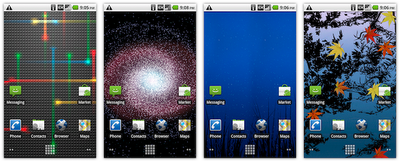Starting with Android 2.1 (API Level 7), users can now enjoy live wallpapers — richer, animated, interactive backgrounds — on their home screens. A live wallpaper is very similar to a normal Android application and has access to all the facilities of the platform: SGL (2D drawing), OpenGL (3D drawing), GPS, accelerometers, network access, etc. The live wallpapers included on Nexus One demonstrate the use of some of these APIs to create fun and interesting user experiences. For instance, the Grass wallpaper uses the phone's location to compute sunrise and sunset times in order to display the appropriate sky.

Creating your own live wallpaper is easy, especially if you have had
previous experience with SurfaceView or Canvas.
To learn how to create a live wallpaper, you should check out the CubeLiveWallpaper sample code.
In terms of implementation, a live wallpaper is very similar to a Service.
The only difference is the addition of a new method, onCreateEngine(), whose goal is to create a WallpaperService.Engine. The engine is responsible for
handling the lifecycle and drawing of a wallpaper. The system provides a surface
on which you can draw, just like you would with a SurfaceView.
Drawing a wallpaper can be very expensive so you should optimize your code
as much as possible to avoid using too much CPU, not only for battery life
but also to avoid slowing down the rest of the system. That is also why the
most important part of the lifecycle of a wallpaper is when it becomes visible, as indicated
by a call to onVisibilityChanged().
When invisible, such as when the user launches an application that covers
the home screen, a wallpaper must stop all activity.
The engine can also implement several methods to interact with the user
or the home application. For instance, if you want your wallpaper to scroll
along when the user swipes from one home screen to another, you can use
onOffsetsChanged().
To react to touch events, simply implement onTouchEvent().
Finally, applications can send arbitrary commands to the live wallpaper.
Currently, only the standard home application sends commands to the
onCommand()
method of the live wallpaper:
android.wallpaper.tap: When the user taps an empty space
on the workspace. This command is interpreted by the Nexus and Water live
wallpapers to make the wallpaper react to user interaction. For instance,
if you tap an empty space on the Water live wallpaper, new ripples appear
under your finger.android.home.drop: When the user drops an icon or a widget
on the workspace. This command is also interpreted by the Nexus and Water
live wallpapers.If you are developing a live wallpaper, remember that the feature is supported only on Android 2.1 (API level 7) and higher versions of the platform. To ensure that your application can only be installed on devices that support live wallpapers, remember to add the following to the application's manifest before publishing to Android Market:
<uses-sdk android:minSdkVersion="7" />, which indicates
to Android Market and the platform that your application requires Android 2.1 or
higher. For more information, see the API
Levels and the documentation for the
<uses-sdk>
element.<uses-feature android:name="android.software.live_wallpaper" />,
which tells Android Market that your application includes a live wallpaper
Android Market uses this feature as a filter, when presenting users lists of
available applications. When you declaring this feature, Android Market
displays your application only to users whose devices support live wallpapers,
while hiding it from other devices on which it would not be able to run. For
more information, see the documentation for the
{@code
<uses-feature>
element.Many great live wallpapers are already available on Android Market and we can't wait to see more!